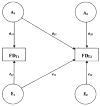Continuity and change in psychopathic traits as measured via normal-range personality: a longitudinal-biometric study
- PMID: 16492099
- PMCID: PMC2242626
- DOI: 10.1037/0021-843X.115.1.85
Continuity and change in psychopathic traits as measured via normal-range personality: a longitudinal-biometric study
Abstract
The discriminant validity of the interpersonal-affective and social deviance traits of psychopathy has been well documented. However, few studies have explored whether these traits follow distinct or comparable developmental paths. The present study used the Multidimensional Personality Questionnaire (A. Tellegen, in press) to examine the development of the psychopathic traits of Fearless Dominance (i.e., interpersonal-affective) and Impulsive Antisociality (i.e., social deviance) from late adolescence to early adulthood in a longitudinal-epidemiological sample of male and female twins. Results from mean- and individual-level analyses revealed stability in Fearless Dominance from late adolescence to early adulthood, whereas Impulsive Antisociality declined over this developmental period. In addition, biometric findings indicated greater genetic contributions to stability in these traits and greater nonshared environmental contributions to their change over time. Collectively, these findings suggest distinct developmental trends for psychopathic traits from late adolescence to early adulthood.
2006 APA, all rights reserved
Figures

References
-
- Benning SD, Patrick CJ, Hicks BM, Blonigen DM, Krueger RF. Factor structure of the Psychopathic Personality Inventory: Validity and implications for clinical assessment. Psychological Assessment. 2003;15:340–350. - PubMed
-
- Blair RJR. The roles of orbital frontal cortex in the modulation of antisocial behavior. Brain and Cognition. 2004;55:198–208. - PubMed
-
- Blumstein A, Cohen J, Farrington DP. Criminal career research: Its value for criminology. Criminology. 1988;26:1–35.

